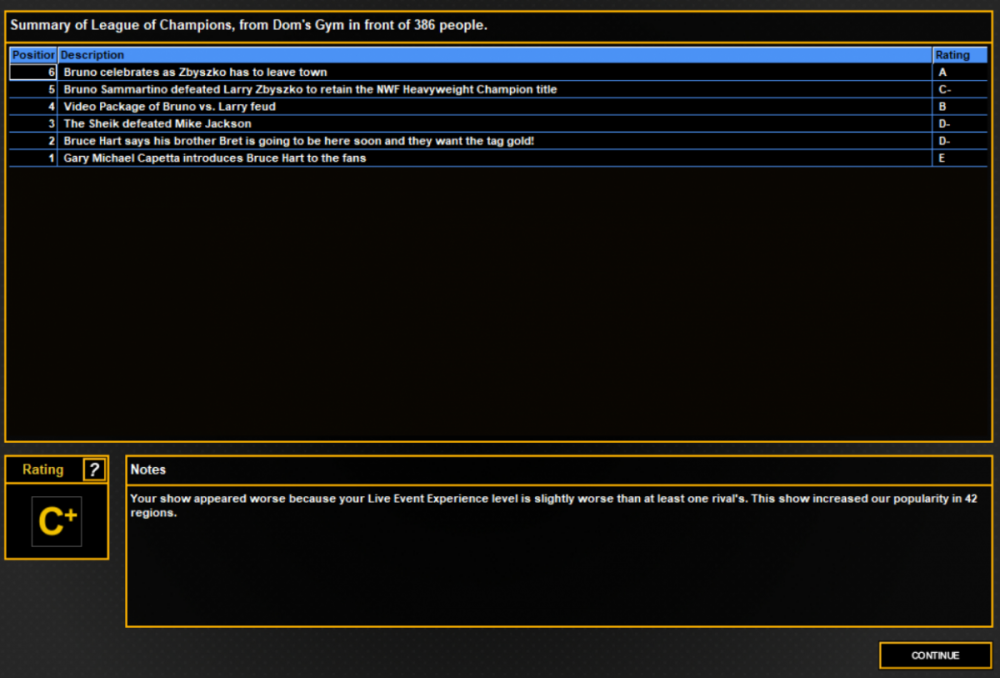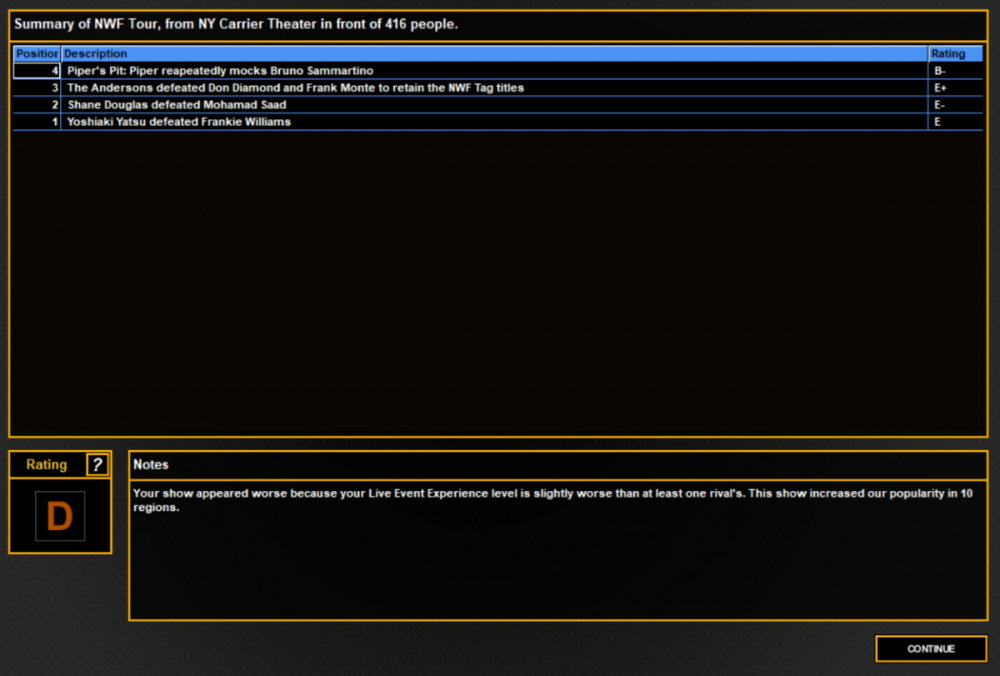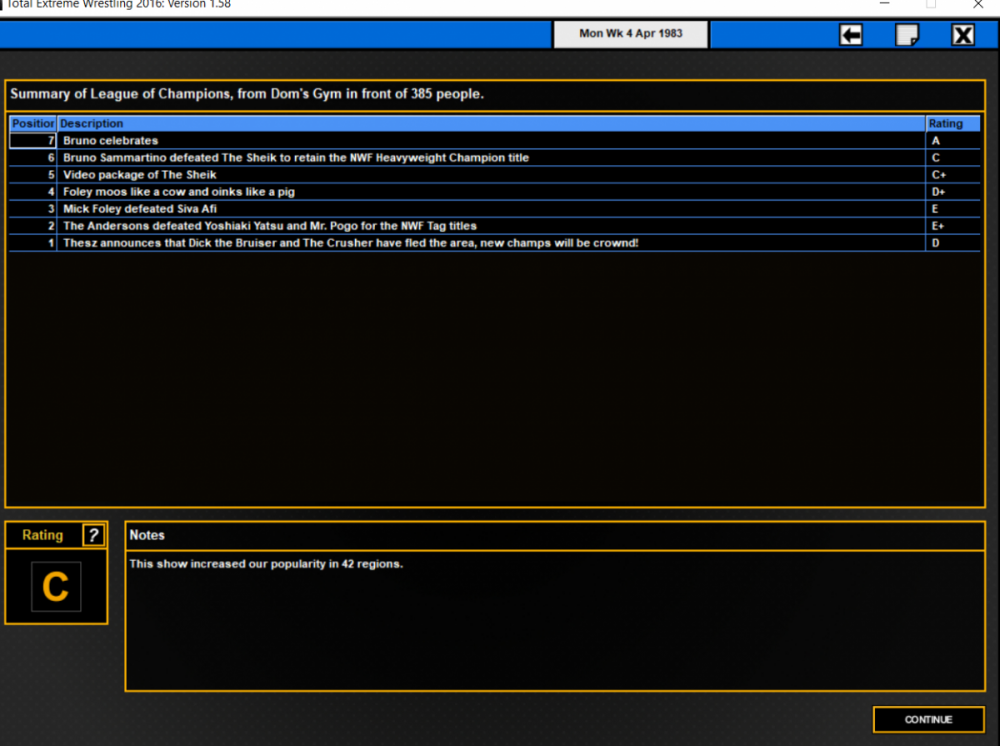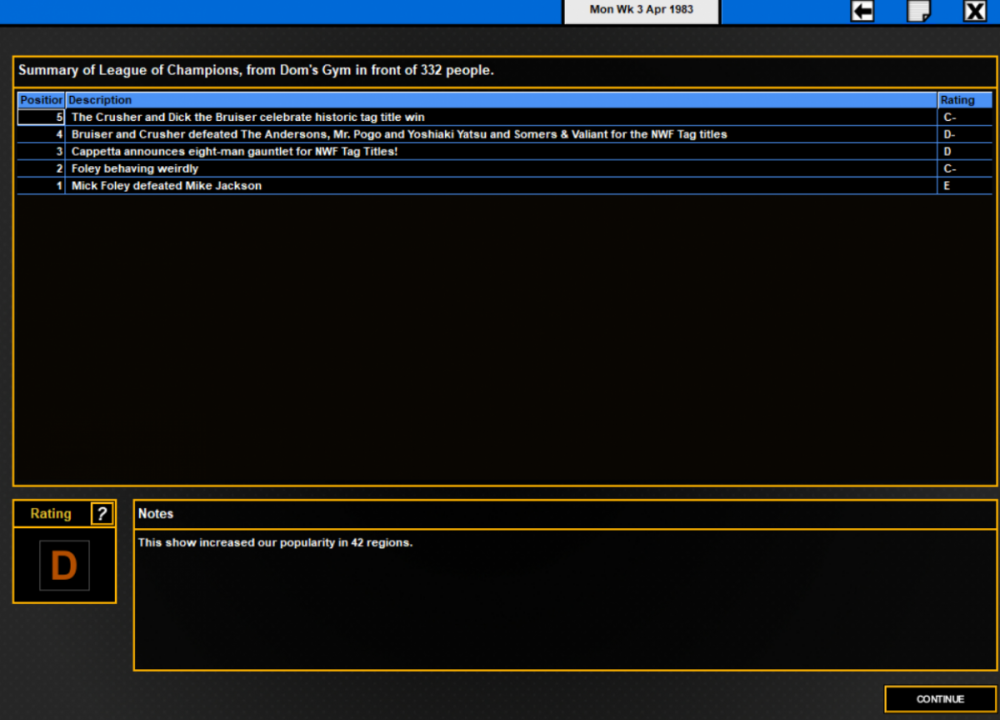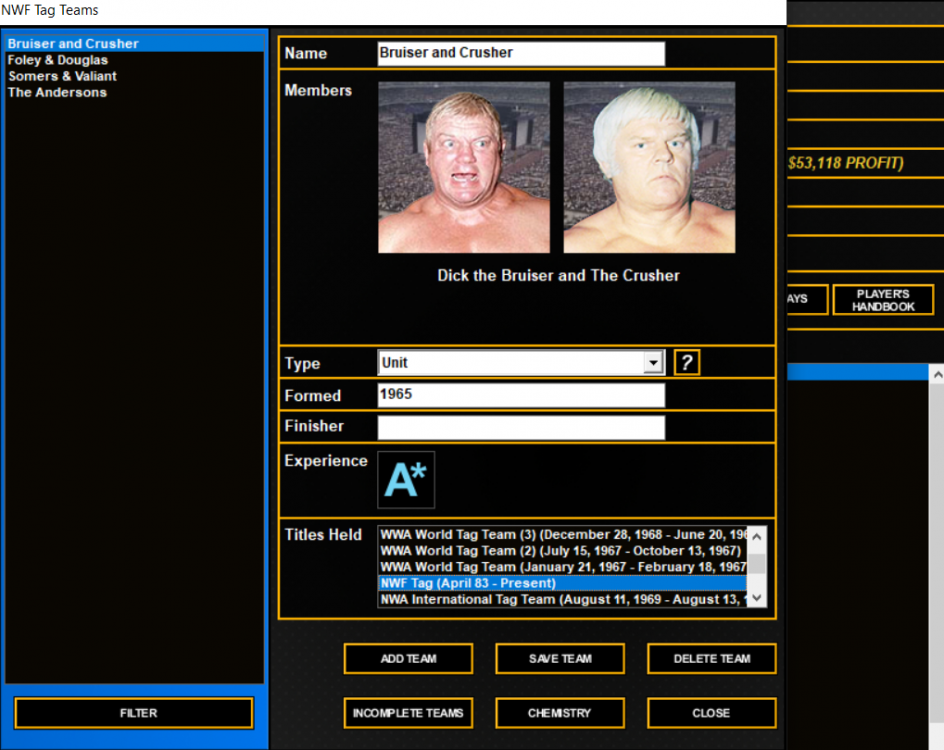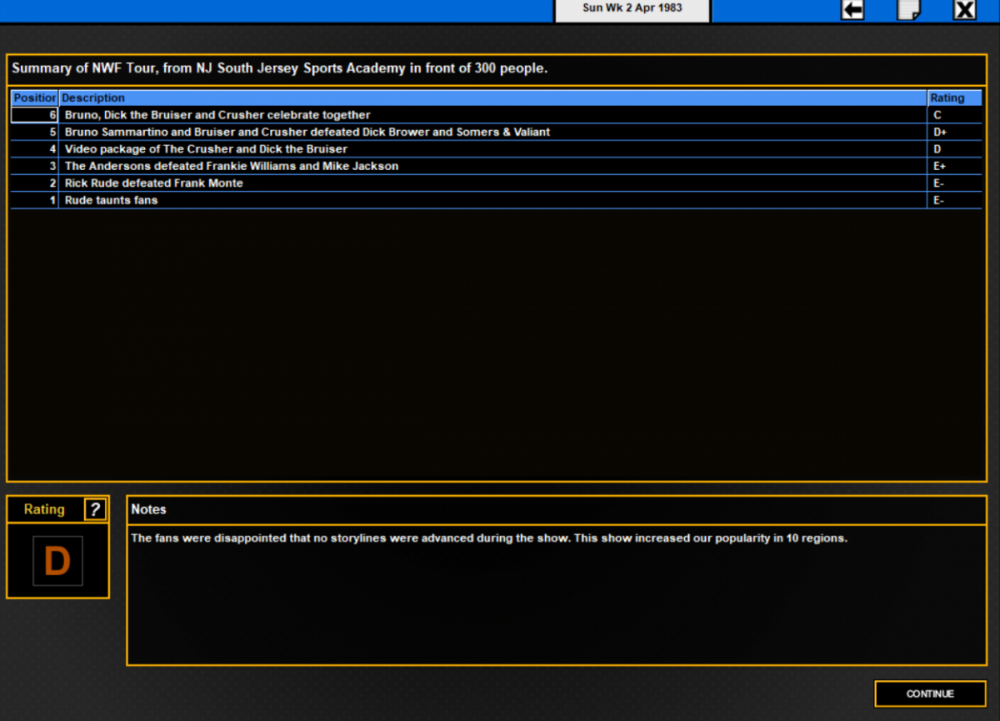-
Posts
11555 -
Joined
-
Last visited
Content Type
Profiles
Forums
Blogs
Everything posted by JerryvonKramer
-
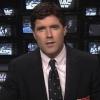
WWF TV Shows 1970s to early 1990s (pre-Raw)
JerryvonKramer replied to JerryvonKramer's topic in Pro Wrestling
When I was researching the big post earlier, I came across a key piece of info that could disprove the mafia connection stuff which is that Joe Salvoldi -- Angelo's son -- worked as a US spy during WW2. Here's a key point: I don't expect the Mob would forgive that easily and I don't expect Vince Sr and co would really have the Salvodis hanging round if there was heat between them and the Mafia. -
In a major coup, NWF has managed to acquire the services of Hulk Hogan on a pay-per-appearance basis for 3 years. Hogan will continue working for the AWA and tours for NJPW throughout this period which will make his availability limited. In a similar deal, Macho Man Randy Savage will be coming in, but the NWF will have to compete with NJPW, CWA, and SECW for his time. And Bruce Hart and Bret Hart have agreed to come in, but will remain working in Stampede at the same time. Another top babyface joining the company is Tommy Rich, who will remain working with GCW. The idea is that "League of Champions" can act as a showcase for talent from all around the country due to its prominent TV slot with Disney, and the Nickelodeon slot can give some national exposure also. This deal works for everyone, hopefully, and should put over NWF as a "destination" promotion within the NWA. It remains to be seen, however, how this talent can be used -- and how the scheduling will work. It's possible that shows will have to move from their Monday and Sunday slots. The League of Champions show blew off the Larry Zbyszko feud as there was no way to drag out this storyline until June with only one appearance left from Larry. The match was good and Bruno got a tremendous response from the live crowd. Elsewhere on the show, Bruce Hart debuted promising his brother Bret will follow. Bret was unavailable for the show. The idea is that The Harts will work a program with the Andersons over the tag titles. The Shiek worked an undercard match winding down his month contract after losing to Bruno last week.
-
Another NWA Tour show on Nickelodeon which has essentially become the B-show for TV. There is very little going on right now because Larry Zbyszko has only one appearance left on his contract to blow off the Bruno feud (with the PPV not until June, it's currently the start of May). Some temptation to drop that storyline and blow it off on TV in order to transition into something. The company is in dire need to storylines. The babyface side of the roster is awful beyond Bruno and there has been a desperate search for talent. Bids for Hulk Hogan, Ricky Steamboat and others have been turned down so far, but trying. This show was a pure placeholder with Bruno appearing on Piper's Pit to tease the possiblity of a program with those two. A tag title defence, and a squash. To give an idea of the thinness of the roster, the only babyface on the books not used on the show was Siva Afi.
-
Encourage people to dig out the Harley Race episode if only for the story about him looking at the mirror with Vince trying to bribe him with $250k to give him the NWA belt. The more Vince stories one hears, the more he really was the real life Million Dollar Man.
-

WWF TV Shows 1970s to early 1990s (pre-Raw)
JerryvonKramer replied to JerryvonKramer's topic in Pro Wrestling
Okay so some more detail about the various functions of the Vince Sr front office. I've consulted many accounts: the Backlund book, old observers, Bruno shoots, Cappetta's book, Superstar Graham shoots, Bill Watts book etc. Vincent J McMahon By all accounts Vince Sr ran the show and he was -- contrary to what you might expect -- fairly hands on. He would have a detailed report about every card even if he wasn't at the arena. Who was late, who was out of line, any funny business, who performed well, who performed poorly, who got over, who didn't, etc. He would only be in the arena for Madison Square Garden shows. Vince Sr still seemed to be booking in 1983 even after Vince Jr took over the reigns -- this is according to the Backlund book -- and if I was to guess this persisted until probably Backlund dropping the belt to Iron Sheik. There are several tell-tale signs in the booking and presentation after that point that have Vince Jr's hands all over them. Apparently, Vince Sr would book the top 3 matches on every card -- you can tell this was the champion, semi-main and tag title. After the IC belt was introduced that became the semi-main. This also shows with angles as there'd only be at most three storylines running at any given time, and lots of the time only two. From what I can make out Vince Sr was very frugal and tight -- despite the fact that the boys typically saw working the North East as a big payday. This was simply because the gate was so much bigger. Senior's tightness can be seen in other ways: he'd stonewall most attempts to ask for a pay rise, Cappetta tells a story about how he made $65 a night for his first four years and was given the brush off by Sr when he asked for more. He did get one eventually, but through Monsoon. he booked MSG shows from a tiny room in The Edison Hotel with his close circle, Billy Graham talks about how it was filled with old guys and was a "surreal" scene. the Allentown Agricultural Hall and Hamburg Fieldhouse were both decrepit, ancient venues with no facilities at all -- Backlund mentions that there were no locker rooms or showers, just a curtain and some chairs that all the workers had to hang out behind. all workers on contract had to give Vince Sr a 25% "kick back" on their pay. So if a guy made $1000 for a show, they'd have to give Vince Sr $250 back. Quite how or why they operated like this I don't know, but Bill Watts tells a story about how he and Bruno would sometimes fail to report 5 shows in the month to pocket the difference. What seems bizarre to me is that Vince Sr would pay these guys and then expect them to give him money BACK? Why not just pay them $750 and be done with it? It also seems that Vince Sr was very conservative in his vision of what wrestling should be. He seemed to want to give the fans as little as possible in order to get "more" out of "less". Whatever we may make of the shows today or his formula, it seemed to work in terms of sell outs and making money. Phil Zacko It seems Zacko had two chief jobs. First, he was the man on the ground at the Philadelphia Spectrum. He also promoted shows as Landover (Cap Centre) and Baltimore. Second, he was the payout guy for the whole promotion. It seems that Vince Sr would go to Philly every third week of the month and sit in Zacko's office. Graham describes it as having a single uncovered light bulb and that Zacko had an almanac. Similar scenes are described by Backlund, Cappetta and Watts. In those monthly meetings, the workers would go in and list all the dates they'd work which Zacko would check against attendance figures in his almanac, and then pay them out accordingly. What I don't understand is how the workers on contract would pay their 25% kick back in that meeting -- since if the Watts story is right, then he and Bruno must have been paid the $1000 already in order to give them the kick back. Confusing and any additional info or insight would be appreciated. Even thought Vince Sr was seen as a fair payoff guy, Zacko was widely perceived to be someone who'd short on the pay -- probably by under reporting the attendance number. This may well explain the famous bust up between Wahoo McDaniel and Zacko which led to McDaniel being blackballed from WWF. How can Vince Sr be a "fair" payoff guy while Zacko was perceived to be skimming from the top while being Vince Sr's pay off guy? I think this can be explained as follows: RELATIVE to all the other territories Vince Sr was paying more (because of the bigger gates), but nonetheless the were still shorting the boys and skimming off the top. Let's say the payoff for one Philly show was $1000 and they got paid only $750, that's still probably double the pay day they'd get in the South, and more than what they got get from Verne in AWA or in Mid-South under McGuirk or Watts. Cappetta describes Zacko as surly, bad-tempered, foul-mouthed, rude and all around a bit of a dick, which seems to be borne out by most accounts -- he seldom comes across well. Most of them make him sound like a stereotypical short fat promoter who chomped on a big cigar -- shades of The Penguin from Batman. Gorilla Monsoon Monsoon seems like he had three main jobs. First, he was Vince Sr's assistant booker -- Vince Sr booked the top 3 matches, Moonsoon booked the undercard. Second, it appears he was responsible for bringing in the undercard talent. As I noted above he owned a 10% stake in WWC in Puerto Rico, and this may well account for why there were so many Puerto Ricans on the WWF undercard in the 70s and early 80s. Monsoon's third job was being the man on the ground in Allentown and Hamburg TV tapings. Given there was no locker room and just a curtain, the "Gorilla position" is much easier to visualise. According to Meltzer, he's take off his glasses to let the workers know to go to a finish. He'd also be sending the reports on what happened on the ground back to Vince Sr. Willie Gilzenberg Before he died in 1978, old-timey boxing promoter Willie Gilzenberg was responsible for promoting New Jersey similar to Zacko in Philly as well as Scranton, PA. He would have been responsible for any shows at the Meadowlands. I suspect he was one of the "old guys" that Billy Graham describes in the Edison Hotel room. From what I can make out, Gilzenberg was more of a guy with connections who could make contact and fix things with local venues or State Athletic Commissions, getting stories into newspapers, that sort of thing -- an actual promoter in other words. I do not know who took over his duties in New Jersey after he died. He also played the WWF's on-air figurehead President -- a precursor to Jack Tunney -- but was very seldom actually seen on TV. Abe Ford This was the promoter for Boston (Gardens), who effectively worked as an agent on the ground for Vince Sr. Angelo Salvoldi Savoldi had a small minority stake in the promotion, and worked as an "on the ground" agent, similar to Zacko or Gilzenberg, but for some of the smaller shows on the loop -- according to Brian Solomon mainly in Massachusetts. So perhaps venues like North Attleboro, MA - Witschi's Sports Arena and Springfield, MA - Civic Center. Tommy Dee Promotor and Vince Sr's agent on the ground for Brooklyn and Staten Island shows. Rudy Miller [ Pennsylvania is a big state and Zacko could not promote all of the towns himself, Miller was another old-time promoter dating back to the days of Toots Mondt and Ray Fabiani. He promoted shows in Pittsburgh, and I think may also have ran the shows at the Zembo Mosque in Harrisburg. I suspect this was another of the "old guys" mentioned by Graham in the Edison hotel. Arnold Skaaland Skaaland had two jobs. First, he was the handler for the champion ensuring they got to venues on time and making arrangements for them and so on -- including acting as their on-air manager. Second, he was the agent on the ground for shows in White Plains, NY. -

Something to Wrestle with Bruce Prichard
JerryvonKramer replied to Lust Hogan's topic in Publications and Podcasts
Can anyone explain to me how it’s humanly possible for someone to have done podcasts with Flair, JR, Bruce Pritchard, Tony Schiavone etc and still to have learned so little about wrestling outside of WWE and WCW? -

WWF TV Shows 1970s to early 1990s (pre-Raw)
JerryvonKramer replied to JerryvonKramer's topic in Pro Wrestling
I’ve just read he had a 10% stake in WWC which he kept for many years. He acquired it in the mid-70s when he worked some headlines for Colon late in his career. Apparently this was one reason why Bruiser Brody was blackballed from WWF. Moonsoon booked the undercard and this is perhaps one reason why there were so many Puerto Ricans: Victor Rivers, Jose Luis Rivera, Jose Estrada ... even Frank Williams was Puerto Rican! Later on I will breakdown the Vince Sr backstage operation in more detail. -

WWF TV Shows 1970s to early 1990s (pre-Raw)
JerryvonKramer replied to JerryvonKramer's topic in Pro Wrestling
There does seem to be this: https://en.wikipedia.org/wiki/Martinez_Familia_Sangeros Notably they worked the New York territory. I don't associate Puerto Ricans in general with organized crime, but I do think "shady shit" whenever I think of Carlos Colon. -

WWF TV Shows 1970s to early 1990s (pre-Raw)
JerryvonKramer replied to JerryvonKramer's topic in Pro Wrestling
That's a hell of a memory on you Sorrow boy. -

WWF TV Shows 1970s to early 1990s (pre-Raw)
JerryvonKramer replied to JerryvonKramer's topic in Pro Wrestling
As more evidence, I submit this from Dave's obit of Gorilla Monsoon in 1999. Now why were the only two Puerto Rican wrestlers on the 1999 roster the only ones in attendance? Why were the Savoldi family there? -

WWF TV Shows 1970s to early 1990s (pre-Raw)
JerryvonKramer replied to JerryvonKramer's topic in Pro Wrestling
So thinking of the core Vince Sr crew, I've been interested in which PARTICULAR areas guys worked in the 1972-83 period. Here's a partial list: All shows Andre the Giant Baron Mikel Scicluna Bulldog Brower Charlie Fulton Chief Jay Strongbow Davey O'Hannon Dominic Denucci Ivan Putski Jack Evans / Mr. X Johnny Rivera Johnny Rodz Jose Estrada Larry Sharpe Mr Fuji Rene Goulet SD Jones Swede Hanson Tony Garea Victor Rivera Mainly Allentown / Hamburg Angelo Gomez Billy Berger Frank Williams Jeff Craney Jose Luiz ("Mac") Rivera Lee Wong Miguel Feliciano Pete Sanchez Ron Shaw (The Executioner) Tony Russo Mainly Philly Tony Altimore Gorilla Monsoon (rare) Mainly MSG Manuel Soto Mainly Maine Pete Dougherty Mainly Buffalo area Tony Parisi ----------- Now, even by the standards of the time, Vince Sr ran an exceptionally jobber-heavy crew. Aside from Chief Jay Strongbow, Ivan Putski and perhaps Tony Garea on the babyface side, and Mr Fuji on the heel side, the roster was made up almost entirely of various grades of jobber. Villains in the promotion were nearly always "passing through" in 3-month or at most 6-month runs. Guys like Ernie Ladd, Ivan Koloff, Don Muraco, Greg Valentine, Buddy Rose, Bob Orton, Spiros Arion, Killer Khan, Sgt Slaughter, Stan Hansen, Superstar Graham, Ken Patera would come in for a run and then move on. There was a general pattern to the heel run at house shows: Match 1 - win over Putski or Strongbow, generally a cheap one with countout or DQ possibly injuring the babyface Match 2 - another win over Putski / Strongbow, sometimes Peter Maivia also in this role Match 3 - cheap finish vs. champ, typically CO or DQ Match 4 - draw Match 5 - clean pin for champ Match 6 - defeat by Putski / Strongbow / Andre Match 7 - defeat by Putski / Strongbow / Andre In the weeks in between on TV naturally they'd just be crushing jobbers and would be given ample mic time. Usually the top contenders were paired with Grand Wizard, but not always. Freddie Blassie would have a lot of the foreign threats. Albano almost always the tag-teams. This system gave the heel strong heat coming in and then allowed the faces to maintain their heat on the way out. Sometimes they'd work MSG loop, sometimes Philly loop, occasionally both. Bruno worked TV very rarely, partly because he was on commentary and only really worked MSG and Philly after the mid-70s on a much reduced schedule. Since the top babyfaces were always Bruno or Backlund followed by Andre as a special attraction followed by Putski and Strongbow, you'd see babyfaces "coming through" the territory much less frequently. However, they did almost always have at least one "young lion" on the roster. These were: Larry Zbyszko - he was the young lion in the promotion for most of the mid-late 70s until his infamous turn on Bruno. Rick Martel - he dropped into the Larry Z sort of slot around 1980ish. Curt Hennig - not as much success as Martel or Zbyszko but booking follows similar pattern. They'd also occasionally have outside stars come in on big shows. Mil Mascaras or Dusty Rhodes. Sometimes a foreign star also, such as The Great Yatsu, would be on the undercard learning the ropes. However, what's of interest here is how many of the cards -- house shows and TV shows -- were made up of jobber bouts. Not only star vs jobber, but in many many cases jobber vs. jobber. Thus, we need to separate out different categories of jobber in the Vince Sr crew. Pure Jobber This was many of those listed under "mainly Allentown", guys who would seldom appear at MSG or Philly Spectrum and instead would take losses on the weekly TV. Frankie Williams is one such example -- he was the sort of guy who'd give up losses to Baron Mikel Scicluna on All Star. On other occasions he might tag with Scicluna to take the pin against a pushed team. But he was a pure jobber through and through. Most of those who chiefly worked Allentown had this role. It seems Tony Altimore played this role on Philly Spectrum shows. Over-the-hill Star / Name-recognition Jobber This is your Baron Scicluna or Bulldog Brower or, later on, on the face side, SD Jones and Rene Goulet. These were guys who were once bigger stars higher up the card who had slid down. They would have some sort of gimmick or recognisable character. Often on house shows they might work 10 minutes or more. Against anyone higher up the card they lose, but against pure jobbers they win, and against each other either a draw or split the difference (sometimes win or lose). Carpenters These were guys who'd work a very large number of cards and did so for many years -- very often in those 10+ minute matches. Very similar level to the over-the-hill star but with less personality, recognition on commentary, and gimmick. Probably the king of these guys was Johnny Rodz, but Jose Estrada, Mac Rivera, Jack Evans, Larry Sharpe all right around here. Babyface JTTS Fodder for Heel Stars So these guys would pretty much autowin against anyone mentioned so far but lose, usually to a flavour-of-the-month pushed heel. More babyfaces in this area naturally such as SD Jones before 1980, Dominic Denucci, Tony Garea. If you look at the match listings for Denucci or Jones you'll notice that those guys would seldom if EVER trade a loss to someone like Baron Scicluna or Bulldog Brower. The only heel who was put on this sort of level that I can see was Swede Hanson. Hanson would trade wins and losses with faces at this level, autowin against anyone lower but lose to a face with any sort of push or Putski / Strongbow / Andre. Using these parameters you could likely PREDICT the outcome of any match just by knowing who was in it. And now for some slight conspiracy. Why is it that over all those years, Vince Sr ran with such a shitty undercard crew? One thing to note is that ethnically, virtually the entire crew was either Italian or Puerto Rican. I am convinced that that they were gangsters. Many of the cards of the era were promoted by Phil Zacko and it seems that he ran most of the core shows aside from MSG from 73 to 83. The Italian contigent wasn't only Bruno and Dominic Denucci: Gorilla Monsoon was Italian, Strongbow was Italian, Tony Parisi, Lou Albano, Tony Altimore -- all Italians. Even Baron Scicluna went by "Mike Valentino" early in his career, and Malta is right next to Sicily. Bruno used to have connections with mobsters when he worked the docks. Bix has shown the FBI investigated Vince Sr's dealings. There is absolutely no doubt in my mind that the whole crew was involved in organized crime in some sort of partnership with Puerto Ricans, which explains also the white-kid-gloves treatment of Carlos Colon whenever he was in town. My theory is this: Vince Sr used this locker room to ensure no one ever tried to stiff him for money or ask for higher pay. It was an unofficial mob. I have read stories from Shane McMahon and Gary Michael Cappetta that it was a rough locker room. Baron Scicluna used to put Cappetta in a trash can and bullied Shane while smoking cigars. How is the perennial prelim guy of 20+ years affording premium cigars? Billy Graham's story from the shoot interview about him not being able to afford a jacket therefore sounds like BS. The other angle this plays into is that after the Mafia went straight they ran most of the newspaper unions, including the NYT for years. After retiring both Denucci and Scicluna (and SD Jones) famously got jobs doing newspaper runs. One reason for this was because they paid a full pension. But another reason might well be because they knew whichever mobsters were running them. Okay that'll do for now. -
Jack Brisco vs Ted DiBiase (2/5/84) Pretty much a dream match for me which Pete sent me earlier (cheers mate!). This is pretty late on for Brisco while Ted is basically in his prime. DiBiase is working heel and was the National Champ at this time, the top belt in GCW. Brisco, of course, owned the territory at this time. This is a well worked match that goes a good 15 minutes, which Brisco controls for large segments. Extended shine sees him working the arm, some neat knee drops. Ted begs in the corner and we get our cut off. His heat sequence consists chiefly of chokes and and a chin lock, and then Brisco is back on top, first working the back and then Ted misses a knee drop and we get a figurefour before Ted manages to get to the ropes for the cheap glove finish. Does pin Brisco clean in the middle though. Decent match with good heat. Ted worked a little too underneath for my tastes because Brisco’s tremendous strength was selling, but he made him look good while keeping his heat and that’s all that was required here. Excellent selling of the leg post-match. ***
-

WWF TV Shows 1970s to early 1990s (pre-Raw)
JerryvonKramer replied to JerryvonKramer's topic in Pro Wrestling
I believe Superstars replaced Action Zone as the clip show on USA Network. -

WWF TV Shows 1970s to early 1990s (pre-Raw)
JerryvonKramer replied to JerryvonKramer's topic in Pro Wrestling
One thing I've just learned is that Joe McHugh and Gary Cappetta switched shows in 1978, before that McHugh did All Star and Cappetta did Championship Wrestling. -
Does anyone have a definitive list of what has been released that is BRAND NEW? I've dug sniffing around this Hidden Gems section since getting the Network again. It's phenomenal.
-

WWF TV Shows 1970s to early 1990s (pre-Raw)
JerryvonKramer replied to JerryvonKramer's topic in Pro Wrestling
JRH - I think after the first few eps Ernie Ladd was replaced by Heenan and Johnny V just came in when Heenan was managing. -

WWF TV Shows 1970s to early 1990s (pre-Raw)
JerryvonKramer replied to JerryvonKramer's topic in Pro Wrestling
Pete, when TNT was on Fridays, what did the first T stand for?! -

WWF TV Shows 1970s to early 1990s (pre-Raw)
JerryvonKramer replied to JerryvonKramer's topic in Pro Wrestling
As a special bonus, I've long been interested in the April 9th 1983 edition of Championship Wrestling. Why? One reason and one reason only: Grand Wizard fills in for Pat Patterson on color for the whole show. I was very interested to see what he might say over the course of an hour. Well, I've finally gotten my hands on this episode. Turns out essentially nothing. Wizard played the heel throughout, which was unusual for this show, but his contributions were more like mini-promos. He mentioned being a good friend to Freddie Blassie, but in the main spoke in general platitudes and stuck to hyping the talent. I was hoping for him to mention random stuff about Phil Zacko or The Sheik or some such, but no cigar. At one point he tried to claim Iron Mike Sharpe was trying to "protect his weak forearm" with the glove, which was quite funny. -
In this thread, I'd like to profile the WWF TV programming before RAW aired in 1993. Other PWO members are encouraged to share trivia, memories and so on of these shows. Championship Wrestling (1972-86) This was the weekly syndicated A-show recorded in Allentown, PA Agricultural Hall featuring Joe McHugh as the ring announcer. Vince McMahon was the play-by-play commentator for the entire run, initially with Antonio Rocca on color, who was later replaced by Bruno Sammartino (1976-80, 84-6) and Pat Patterson (80-83). Up until 1984, this show has a very specific look and feel. But then the title theme changed to an instrumental version of Michael Jackson's Thriller with Hulk Hogan featured prominently in the title sequence. Tapings were moved from Allentown to Poughkeepsie, NY; Mid-Hudson Civic Center and there was no more Joe McHugh. Gene Okerlund was added to the team around this time, sometimes as co-host to Vince but mostly as an interviewer. The 1985-6 Championship Wrestling is an interesting "transitional" show which feels a bit more modern than the traditional show but still not as bright and colourful as Superstars would be, often with the arena blackened. All-Star Wrestling (1972-86) All-Star was the B-show recorded in Hamburg, PA, Fieldhouse featuring Gary Michael Capetta as the ring announcer. For most of its run this had exactly the same commentary team as Championship Wrestling, but with its own distinct look and feel. Then in 1984 it moved to Ontario in Canada and was taped first at the London Gardens and then from 1985 onwards at the Bradford Civic Centre. Vince McMahon handed over hosting duties to Jack Reynolds around this time who was joined by Angelo Mosca. The Reynolds / Mosca pairing was replaced in 85 by Gorilla Monsoon and Jesse Ventura. All-American (1983-94) This was the first WWF cable show on USA Network. Vince bought the slot from Joe Blanchard's Southwest Championship Wrestling. The first few shows are interesting career retrospectives of Bob Backlund, Jimmy Snuka and Andre hosted by Vince, but after that it morphed into a kind of "showcase" for talent from the territories from all around the country. The idea was that Vince wanted to introduce audiences to these stars before they came to the WWF. This didn't last for too long however, and soon enough it became more of a clip show hosted by Lord Alfred Hayes with one "feature" bout from a house show (MSG, Philly, Meadlowlands, etc.) -- similar to the format Prime Time would have later on. In 1984, Gene Okerlund took over as host and stayed there until 1993 until he left for WCW and Todd Pettigall took over. For most of its run after its first year, All-American was the B-show on cable. t became Action Zone in 1996 which USA Network cancelled. Tuesday Night Titans (1984-6) Vince famously got around USA Network's sniffiness about having too much wrestling on TV by giving them this "variety show" fronted by himself and Lord Alfred Hayes. TNT remains an amazing Time Capsule piece chronicling the transition of the WWF product from the old Vince Sr brand to Jr's sports entertainment vision. For hardcore fans, it is especially interesting when older stars are featured and brought in for inexplicably long interviews. Older stars that Vince spoke to include: Lou Thesz, Red Bastien, Tony Altimore, referee Dick Worhle, and Baron Scicluna. These segments are quite surreal. For more casual fans, there is a boatload of nonsense on this show including Andre's "fish dance", Lord Al trying Mexican food, Mr Fuji teaching us Japanese customs, Dick Murdoch trashing Chief Jay Strongbow's Pow Wow and much more. WWF Spotlight (1984-95) Originally called "Superstars of Wrestling", this was the syndicated C-show featuring clips mostly hosted by Lord Alfred Hayes and later by Sean Mooney. This is an interesting little show mainly because it was one of the more "off the radar" productions and featured such hidden running gags as "Ian Mooney" documented on the smash hit wrestling podcast Letters from Kayfabe. WWF Superstars (1986-01) This replaced Championship Wrestling as the syndicated A-show and moved the show to follow the WWF tour coming from arenas all around the country. There is a marked shift in the look and feel of the WWF product around this time: it becomes a lot brighter and more colourful, and there are distinctive Superstars banners in the venues and on the ring apron. The hosts for the main part were Vince McMahon and Jesse Ventura, with Roddy Piper replacing Ventura followed by Randy Savage, Mr Perfect, Jerry Lawler and Dok Hendrix. In 1995, Vince finally gave up hosting duties -- technically ending a 23-year continuous streak of hosting the show -- and gave the reigns to Jim Ross. Jim Cornette became the colour man in 1996, but around this time the show transferred onto the USA Network and effectively replaced Spotlight / Action Zone as a C-show / clip show hosted by Todd Pettigall -- a sad end to a once great flagship programme. For most of its run between 1986 and 1993 almost all of the main angles and storylines would occur on Superstars, and the main event would occasionally be a star vs. star match. There were also some title changes on the show. Wrestling Challenge (1986-95) This replaced All-Star Wrestling as the syndicated B-show and, like Superstars, followed the WWF tour around the country. The hosts were mostly Gorilla Monsoon and Bobby Heenan until 1993 when Jim Ross would replace Monsoon, and Heenan was replaced by, first Stan Lane, and then Ted DiBiase for most of 94-5. Challenge typically featured fewer angles and more jobber matches than Superstars, but was very much a show in its own right. WWF Prime Time Wrestling (1985-93) This effectively replaced All American as the A-show on USA Network. Hosted by Gorilla Monsoon and Bobby Heenan from a studio, it would feature bouts from various WWF houseshows such as MSG, Philly Spectrum, Meadowlands, Capital Centre etc. as well as clips of key events from the syndicated shows such as Superstars and Challenge. Prime Time is notable not only for the superb on-air chemistry between Monsoon and Heenan, as well as their various funny skits in the studio, but also for featuring much more top-flight wrestling owing to the house show footage. The average match on Superstars or Challenge was a squash match going for 2 or 3 minutes maximum. On Prime Time, it was not unusual to see matches running for 15 minutes or more and star vs. star bouts. In 1991, Prime Time switched to being a studio-based show with a tiny crowd hosted by Vince and Bobby Heenan, although Vince would be replaced by Sean Mooney. This second version of Prime Time is a weird show but does have some memorable moments including the introduction of the Iron Shiek as "Col Mustafa" and Ric Flair bringing the NWA title to the WWF. The format then switched again to the "roundtable panel" hosted by Vince with Gorilla Monsoon and Heenan almost always part of the lineup -- other frequent guests of this era included Mr Perfect and Hillbilly Jim. The show was replaced by Raw in 1993.
-
League of Champions tonight saw a thirty-minute epic between The Andersons and Yatsu/Pogo for the vacant NWF tag titles that fell quite flat with the crowd because of the slow, technical nature of the wrestling on display. The Andersons are the new NWF tag champions nonetheless. Bruno squared off against one of his legendary rivals, The Sheik who was reunited with his manager in the 13th defence of his NWF title. Elsewhere on the card, Mick Foley weirded out the crowd following a squash by making animal noises.
-
On tonight's NWF Tour on Nickleodeon, Dick the Brusier and The Crusher defend their tag titles against Somers and Valiant. Unfortunately, following a bust-up backstage after the match, Dick the Bruiser and The Crusher fell out with the management and stormed out of the company!! The new tag belts are now vacant. Also on tonight's show, Roddy Piper debuted his new chat segment, Piper's Pit on which The Grand Wizard was reunited with The Sheik who will be trying to win Bruno's title next Monday. Meanwhile, on the undercard, Rick Rude taunted the fans and beat a jobber. Unfortunately, Rude was legit injured during the match and will be out for a couple of weeks.
-
Another episode of League of Champions, and this week saw the introduction of the NWF Tag Titles. A unique four-way elimination tag match was used to establish the new champions featuring wrestlers from all around the world: representing Japan were Yoshiaki Yatsu and Mr Pogo. Coming in from down south were The Andersons. Representing the home-town heroes, Dick the Bruiser and The Crusher. And finally, Doug Somers and Jerry Valiant rounded out the eight. The match went for over 30 minutes but in the end The Crusher and Dick the Bruiser scored an historic victory. This is the 14th time the pair have held gold together. They won their first gold 20 years ago in 1963, and the pair were very emotional to be in the big time once again. Elsewhere on the card, Mick Foley destroyed Mike Jackson and then started making strange noises and yelping which freaked out many of the fans at ringside.
-
The weekly tour which takes place on Fridays now being shown by Nickleodeon, is a good place to debut new talent. Here Rick Rude came in with his new "Ravishing" gimmick telling fans that the women in the crowd were going to get a look at a "real man". Ole Anderson has come into the territory with a new "cousin" calling himself Arn Anderson. They made short work of Mike Jackson and Frankie Williams. Meanwhile, in the main event, Dick the Brusier and The Crusher made a sensational return to the world of pro wrestling teaming up with Bruno Sammartino in a six-man.
-
Billy Robinson is on his way out and just as well because he picked up an injury putting over Larry Z. Zbyszko is back with no explanation and during the match Bruno came down furious about him no showing Supercard 1983. Later on, following a routine title defence against his old rival Baron Scicluna (who has been sent to rehab following painkiller abuse), Larry Z attacked Bruno with a chair. Bobo Brazil is continuing to put over Foley on his way out. Now, a slew of new signings! Roddy Piper! Tick Rude! Randy Savage! Arn Anderson! Ole Anderson! And on short-term deals: The Crusher! Dick the Bruiser! The Shiek! And a Japanese tag team: The Great Yatsu and Mr Pogo.
-
Leroy McGuirk MidSouth from 1978 is something!

